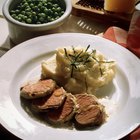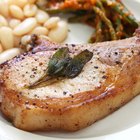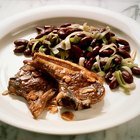
Whether from a farm-raised yearling or a wild-caught trophy buck, the tenderest cut of all venison is its tenderloin. Sometimes called the "inside loin" because of its position inside the body cavity and under the spine, it's a small oblong muscle about the same size and shape as a pork tenderloin. It's remarkably tender even in a mature animal and lean even by venison standards. It's best when cooked to no more than medium-rare, either as a whole tenderloin or as medallions.
Preparing the Tenderloin
Step 1
Lay the tenderloin on your cutting board and use a sharp, thin-bladed knife to trim away any seams of surface fat.
Step 2
Locate the thin, gray sheath of filmy connective tissue, called silverskin, that covers the tapered end of the tenderloin. Slide the tip of your knife underneath the silverskin and cut away a strip, keeping your knife angled toward the silverskin to minimize waste.
Step 3
Continue to take off the silverskin in thin strips, until the surface of the tenderloin is bared.
Cooking the Whole Tenderloin
Step 1
Season the tenderloin liberally with salt and pepper or other flavorings, if you wish. Fold the thin, tapered ends underneath the loin and tie them with cotton butcher's twine so the whole tenderloin is approximately the same diameter from end to end.
Step 2
Place the tenderloin on your oven's broiler pan. Position a rack in the top third of your oven, so that when the pan sits on the rack the tenderloin is 4 to 5 inches from the element. Remove the pan and preheat the broiler.
Step 3
Brush the tenderloin lightly with oil or melted butter. Slide the broiler pan back into the oven once it's heated, and broil the tenderloin for a total of seven to 10 minutes, depending on its size and the degree of doneness you prefer. Turn it halfway through its cooking time to ensure even cooking.
Step 4
Remove the tenderloin from your oven and let it rest, loosely covered with foil, for at least five to eight minutes before serving.
Cooking Medallions
Step 1
Trim away the thin ends of the tenderloin, and cut the rest into medallions 1 1/2 to 2 inches thick. The ends can be reserved for another use, or you can use cotton butcher's twine to tie two or more pieces together and make medallions similar in size to the others.
Step 2
Preheat a grill or heavy skillet to medium-high heat. Lightly brush or spray the medallions with oil, and season them with salt and pepper.
Step 3
Sear the medallions until well browned, approximately three to four minutes. Turn them and cook for another two to three minutes or until they reach your desired degree of doneness.
Step 4
Rest the medallions for three to five minutes before serving.
Related Articles

How to Cook Pork Chops on an Electric ...
How to Cook a Lamb Square Cut Shoulder

How to Bake a Pork Loin Center Half
How to Cook Goat Steak
How to Cook Buffalo Fillet

How to Cook Marinated Pork Loin From a ...

How to Cook Beef Tenderloin on a ...

Roasting Instructions for a Half Loin ...
How to Cook Double Thickness Rib Lamb ...

How to Cook a Thresher Shark Steak

How to Grill a Ribeye on a Weber Q

How to Cut a Cooked Pork Shoulder

How to Cook Tender Rolled Flank Steaks ...

How to Grill Iowa Chops

Cooking Instructions for Lamb Chops

How to Broil Filet Mignon Wrapped in ...

How to Cook a Petite Filet of Beef in ...

How to Cook Thin Cut Butterfly Pork

How to Pan Cook Shark

How Long Do You Cook Whole Deer ...
References
- Cooking Wild in Kate's Kitchen: Fabulous Venison Dishes from Fast to Fancy; Kate Fiduccia
- U.S.D.A. Food Safety and Inspection Service: Game From Farm to Table
Resources
Tips
- Whole tenderloins can be cooked in the same way on a grill or in a hot skillet or can be roasted at 400 Fahrenheit for 12 to 15 minutes.
- Most game enthusiasts recommend cooking venison tenderloin to no more than 145 F, or approximately medium-rare. Past that temperature, it becomes chewy and dry and loses its delicate flavor. The U.S.D.A.'s official recommendation for game is to cook it to 160 F to minimize the risk of trichinosis. As with rare steaks or soft egg yolks -- also counter to the U.S.D.A.'s guidelines -- each diner must weigh the risks and rewards. The elderly, pregnant and nursing women, or anyone with a compromised immune system should error on the side of caution.
Writer Bio
Fred Decker is a trained chef and prolific freelance writer. In previous careers, he sold insurance and mutual funds, and was a longtime retailer. He was educated at Memorial University of Newfoundland and the Northern Alberta Institute of Technology. His articles have appeared on numerous home and garden sites including GoneOutdoors, TheNest and eHow.
Photo Credits
Jupiterimages/Stockbyte/Getty Images